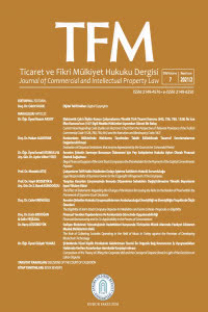AVRUPA BİRLİĞİ HUKUKU UYARINCA MARKANIN "GERÇEK KULLANIM" PROBLEMİ
'GENUINE USE' OF TRADEMARK PROBLEMATIQUE IN THE COURSE OF EUROPEAN UNION LAW
___
- Barinbridge, David (2007), I. Intellectual Property, London. Pearson Longman.
- Bently, Lionel & Sherman, Brad (2004), Intellectual Property Law, 2nd. ed., London, Oxford University Press.
- Elias, Stephen R. (2005), Trademark: Legal Care for Your Business & Product Name, 7th ed. Berkeley, CA, USA: Nolo.
- Phillips, Jeremy & Simon, Ilanah (2005), Trade Mark Use, (edited), US, Oxford University Press.
- Seville, Catherine (2009), EU Intellectual Property Law and Policy, London, Elgar European Law Publication.
- Tritton, Guy (2008), Intellectual Property in Europe, London, Sweet & Maxwell Press. Von Bomhard, Verena & Pagenberg, Jochen &
- D. Schennen, Detlef (eds.) (2005), Harmonisierung des Markenrechts, Festschrift für Alexander von Mühlendahl, Berlin, Carl Heymanns Verglag. OHIM, The Manual concerning Opposition Part 6: Proof of Use, 14 September 2009. Makaleler
- Bolton, Emily (2011), 'Defining Genuine Use Requirements of Community Trade Markas in Light of an Expanding European Union', Connecticut Journal of International Law, Vol 27, pp. 371-389.
- Bugge, Jens Jakob & Gregersen Peter E.P. (2003), Requirement of Use of Trade Marks', EIPR, Vol. No 25 (7), pp. 309-321.
- Duran, Luis-Alfonso (2005) 'Geographical scope of the use requirement for Community Trademarks', Berlin, Carl Heymanns Verglag, pp. 333-340.
- Gielen, Charles (2011), 'Netherlands: Trade Marks - Meaning of 'genuine use' of a Trade Mark', EIPR,Vol. 23(9), pp. N140.
- Gielen, Charles (2010), 'Leno Merken BV v Hagelkruis Beheer BV: Benelux - trade marks - use of a CTM in One Country Insufficent to Constitute "genuine use"', EIPR, Vol. No. 32(5), pp. N27-28.
- Howell, Claire F. (2006), 'What constitutes "genuine use"? Laboratories Goemar SA v LaMer Technology', EIPR, Vol. No. 28(2) pp. 118-121.
- Kur, Annette (2012), 'Convergence After All? A Comparative View on the U.S and EU Trademark Systems in the Light of the 'Trade Mark Study', Journal of Intellectual Property Law, 305, pp. 305-324.
- Morcom, Christopher (2010), 'Hagelkruis Beheer BV v Leno Merken BV: Genuine use in the community - What does the CTMR require?', EIPR, 32(7), pp. 359-362.
- von Muhlendahl, Alexander (2008), Community Trade Mark Riddles: Territoriality and Unitary Character, EIPR, 30(2), pp. 66-70 .
- C-292/89 The Queen v. The Immigration Appeal Tribunal, ex parte Gustaff Desiderius Antonissen [1991] ECR p. I-00745.
- C-375/97 General Motors Corp v. Yplon SA, [1999] ECR p. I-542.
- C-40/01 Ansul BV v Ajax Brandbeveiliging BV, [2003] ECR p. I-2439.
- C-259/02 La Mer Technology Inc v Laboratoires Goemar SA, [2004] ECR p. I-01159.
- C-371/02 Björnekulla Fruktindustrier AB v. Procordia Food AB, [2004] ECR p. I-5791.
- C-416/04 P, The Sunrider Corp. v. OHIM, [2006] ECR p. I-4237.
- C-442/07 Verein Radetzky-Orden v. Bundesvereinigung Kameradschaft, [2008] ECR I-9223.
- C-149/11 Leno Merken BV v. Hagelkruis Beheer BV, 19 December 2012 [2013] E.T.M.R. p. 16.
- T-39/01 Kabushiki Kaisha Fernandes v. OHIM, [2002] ECR p. II-5233.
- T-334/01 MFE Marienfelde GmbH v. OHIM - intervener Vetoquinol AG [2004] ECR p. II-2787. T-203/02 The Sunrider Corp v. OHIM, [2004] ECR p. II-2787.
- T-325/06 Boston Scientific Ltd v OHIM, [2008] ECR p. II-174 (summay published).
- No 827/2000 Marco/Marca Opposition Guidelines, Part 6, Proof of use - Status: March 2004
- p. 17and 42; OAMI-HABM-OHIM-OHMI-UAMI DO-ABl.-OJ-JO-GU 2/2003 p. 378.
- No 802/1999 Miles/More Miles, cited from OHIM Opposition Guidelines, Part 6, Proof of use - Status: March 2004 p. 18. Web Kaynakları
- _____http://ec.europa.eu/internal_market/indprop/ docs/tm/20110308_allensbach-study_en.pdf> s.e.t. 28.01.2014.
- _____http://curia.europa.eu/ > s.e.t. 20.12.2014.
- _____http://eur-lex.europa.eu/legal-content/EN/ TXT/HTML/;jsessionid=8TxmTYTbycnp08Q31 ygyTSwsWJpTSkpPQytwD81hx0zPQsQcpvVC!1395015523?isOldUri=true&uri=CELEX:- 61989CJ0292> s.e.t. 28.05.2014.
- _____http://oami.europa.eu/en/mark/aspects/reg/ reg4094.htm > s.e.t. 01.04.2014.
- _____http://oami.europa.eu/en/mark/aspects/pdf/ JJ020371.pdf> s.e.t. 04.04.2014.
- _____http://ec.europa.eu/internal_market/indprop/ docs/tm/20110308_allensbach-study_en.pdf> s.e.t. 07.04.2014.
- _____http://www.internationallawoffice.com/newsletters/detail.aspx?g=e968e049-ccb0-4306-9711-ce- 0ca9bfdf4a&redir=1> s.e.t. 28.05.2014.
- ISSN: 2149-4576
- Yayın Aralığı: 2
- Başlangıç: 2015
- Yayıncı: Ankara Yıldırım Beyazıt Üniversitesi Hukuk Fakültesi
ANONİM ŞİRKETLERDE RİSKİN ERKEN SAPTANMASI VE YÖNETİMİ
Neeruganti Shanmuka SREENIVASULU
Avrupa Birliği Hukuku Uyarınca Markanın “Gerçek Kullanım” Problemi
İSPANYA VE TÜRKİYE KARŞILAŞTIRMALI ANONİM ORTAKLIKLARIN YÖNETİMİ
Management of Joint Stock Companies: Spain and Turkey Compared
AVRUPA BİRLİĞİ HUKUKU UYARINCA MARKANIN "GERÇEK KULLANIM" PROBLEMİ
MARKANIN İZİNSİZ KULLANIMI : AVRUPA ADALET DİVANI'NIN C-179/15 SAYILI KARARI
MARKANIN AYIRT EDİCİ NİTELİĞİ : AVRUPA BİRLİĞİ ADALET DİVANI'NIN C-421/13 SAYILI KARARI
Markanın Ayırt Edici Niteliği: Avrupa Birliği Adalet Divanı’nın C– 421/13 Sayılı Kararı
